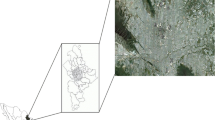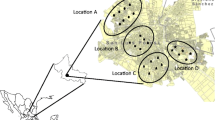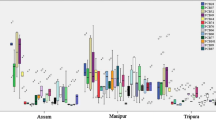Abstract
The contamination of persistent organic pollutants (POPs), including dichlorodiphenyltrichloroethane (DDT), hexachlorocyclohexane (HCH), and polycyclic aromatic hydrocarbon (PAH), is the most studied environmental issue. In 2020, a total of sixty soil samples collected from ten locations in Guiyang were analyzed to assess the presence of four DDTs and HCHs and sixteen PAHs. The concentrations of total DDTs, total HCHs and Σ16PAHs in the soil were between 0.26 and 12.76, 0.23 and 51.80 μg/kg, and 10.02 and 1708.86 μg/kg, respectively. The mean and median concentrations of total DDTs, total HCHs and Σ16PAHs in the soil were 1.04 and 0.26 μg/kg, 4.32 and 0.23 μg/kg, 139.14 and 98.98 μg/kg, respectively. p,p′-DDT, p,p′-DDD and γ-HCH the dominant organochloride pollutants in the soil, while 4-ring PAHs were the dominant PAHs, occupying 41.1–53.6% of the total PAHs in the soil. The highest levels of PAHs in the soil were observed in areas of Guiyang with relatively larger population densities and more developed heave industries. Various diagnostic tools were used to identify the potential sources of the POPs in the soil. The data indicated that DDTs and HCHs were from past and recent common inputs and that mixtures of several combustion activities (biomass, coal and petroleum combustion, diesel, gasoline, and vehicular emissions) were the major sources of PAHs in the Guiyang soil. The results provide information for the assessment of the extent of POP pollution in the Guiyang soil and can help authorities establish environmental protection regulations and soil remediation techniques.



Similar content being viewed by others
References
Aislabie, J. M., Richards, N. K., & Boul, H. L. (1997). Microbial degradation of DDT and its residues-a review. New Zealand Journal of Agricultural Research, 40, 269–282.
Bao, H. Y., Hou, S. W., Niu, H., Tian, K., Liu, X. P., & Wu, F. Y. (2018). Status, sources, and risk assessment of polycyclic aromatic hydrocarbons in urban soils of Xi’an, China. Environmental Science and Pollution Research, 25, 18947–18959.
Barber, J. L., Sweetman, A. J., Van Wijk, D., & Jones, K. C. (2005). Hexachlorobenzene in the global environment: Emissions, levels, distribution, trends and processes. Science of the Total Environment, 349, 1–44.
Bhatt, P., Kumar, M. S., & Chakrabarti, T. (2009). Fate and degradation of POP-hexachlorocyclohexane. Critical Reviews in Environmental Science and Technology, 39, 655–695.
Cai, C. Y., Li, J. Y., Wu, D., Wang, X. L., Tsang, D. C. W., Li, X. D., Sun, J. T., Zhu, L. Z., Shen, H. Z., Tao, S., & Liu, W. X. (2017). Spatial distribution, emission source and health risk of parent PAHs and derivatives in surface soils from the Yangtze River Delta, eastern China. Chemosphere, 178, 301–308.
Chakraborty, P., Khuman, S. N., Selvaraj, S., Sampath, S., Devi, N. L., Bang, J. J., & Katsoyiannis, A. (2016). Polychlorinated biphenyls and organochlorine pesticides in River Brahmaputra from the outer Himalayan Range and River Hooghly emptying into the Bay of Bengal: Occurrence, sources and ecotoxicological risk assessment. Environmental Pollution, 219, 998–1006.
Chen, M., Huang, P., & Chen, L. (2013). Polycyclic aromatic hydrocarbons in soils from Urumqi, China: Distribution, source contributions, and potential health risks. Environmental Monitoring and Assessment, 185, 5639–5651.
Chung, M. K., Hu, R., Cheung, K. C., & Wong, M. H. (2007). Pollutants in Hong Kong soils: Polycyclic aromatic hydrocarbons. Chemosphere, 67, 464–473.
Dickhut, R. M., Canuel, E. A., Gustafson, K. E., Liu, K., Arzayus, K. M., Walker, S. E., Edgecombe, G., Gaylor, M. O., & MacDonald, E. H. (2000). Automotive sources of carcinogenic polycyclic aromatic hydrocarbons associated with particulate matter in the Chesapeake Bay region. Environmental Science and Technology, 34, 4635–4640.
Ghanavati, N., Nazarpour, A., & Watts, M. J. (2019). Status, source, ecological and health risk assessment of toxic metals and polycyclic aromatic hydrocarbons (PAHs) in street dust of Abadan Iran. Catena, 177, 246–259.
Han, Y. M., Bandowe, B. A. M., Wei, C., Cao, J. J., Wilcke, W., Wang, G. H., Ni, H. Y., Jin, Z. D., An, Z. S., & Yan, B. Z. (2015). Stronger association of polycyclic aromatic hydrocarbons with soot than with char in soils and sediments. Chemosphere, 119, 1335–1345.
Hu, G. J., Chen, S. L., Shi, W., Zhang, B. B., Zhang, Y., Huang, J., & Yu, H. X. (2015). Identification of polycyclic aromatic hydrocarbons in soils in Taizhou, East China. Environmental Geochemistry and Health, 37, 429–439.
Kanaly, R. A., & Harayama, S. (2000). Biodegradation of high-molecular-weight polycyclic aromatic hydrocarbons by bacteria. Journal of Bacteriology, 182, 2059–2067.
Kata, M., Rao, S. S., & Mohan, K. R. (2015). Spatial distribution, ecological risk evaluation and potential sources of organochlorine pesticides from soils in India. Environment and Earth Science, 74, 4031–4038.
Khalili, N. R., Scheff, P. A., & Holsen, T. M. (1995). PAH source fingerprints for coke ovens, diesel and gasoline engines, highway tunnels, and wood combustion emissions. Atmospheric Environment, 29, 533–542.
Kim, J. T., Choi, Y. J., Barghi, M., Kim, J. H., Jung, J. W., Kim, K., Kang, J. H., Lammel, G., & Chang, Y. S. (2021). Occurrence, distribution, and bioaccumulation of new and legacy persistent organic pollutants in an ecosystem on King George Island, maritime Antarctica. Journal of Hazardous Materials, 405, 124141.
Kim, L. S., Lee, D. B., Cho, H. K., & Choi, S. D. (2019). Review of the QuEChERS method for the analysis of organic pollutants: Persistent organic pollutants, polycyclic aromatic hydrocarbons, and pharmaceuticals. Trends in Environmental Analytical Chemistry, 22, e00063.
Kudłak, B., & Namieśnik, J. (2008). Environmental fate of endocrine disrupting compounds—Analytical problems and challenges. Critical Reviews in Analytical Chemistry, 38, 242–248.
Kumar, B., Verma, V. K., Mishra, M., Piyush, K. V., Tiwari, A., Kumar, S., Yadav, V. P., & Gargava, P. (2021). Assessment of persistent organic pollutants in soil and sediments from an urbanized flood plain area. Environmental Geochemistry and Health. https://doi.org/10.1007/s10653-021-00839-9
Li, X. H., Ma, L. L., Liu, X. F., Fu, S., Cheng, H. X., & Xu, X. B. (2006). Polycyclic aromatic hydrocarbon in urban soil from Beijing, China. Journal of Environmental Sciences, 18, 944–950.
Liu, S. D., Xia, X. H., Zhai, Y. W., Wang, R., Liu, T., & Zhang, S. W. (2011). Black carbon (BC) in urban and surrounding rural soils of Beijing, China: Spatial distribution and relationship with polycyclic aromatic hydrocarbons (PAHs). Chemosphere, 82, 223–228.
Liu, X. G. (2021). Distribution characteristics of persistent organic pollutants in water environment based on evolutionary stabilization strategy. Arabian Journal of Geosciences , 14, 640.
Loick, N., Hobbs, P. J., Hale, M. D. C., & Jones, D. L. (2009). Bioremediation of poly-aromatic hydrocarbon (PAH)-contaminated soil by composting. Crit Rev Env Sci Tec, 39, 271–332.
Ma, W. L., Li, Y. F., Sun, D. Z., & Qi, H. (2009). Polycyclic aromatic hydrocarbons and polychlorinated biphenyl in topsoils of Harbin, China. Arch Environ Con Tox, 57, 670–678.
Malaiyandi, M., & Shah, S. (1980). Evidence of photoisomerization of hexachlorocyclohexane isomers in the ecosphere. Journal of Environmental Science & Health Part A, A19, 887–910.
Maliszewska-Kordybach, B. (1996). Polycyclic aromatic hydrocarbons in agricultural soils in Poland: Preliminary proposals for criteria to evaluate the level of soil contamination. Applied Geochemistry, 11, 121–127.
Marr, L. C., Kirchstetter, T. W., & Harley, R. A. (1999). Characterization of polycyclic aromatic hydrocarbons in motor vehicle fuels and exhaust emissions. Environmental Science and Technology, 33, 3091–3099.
Martijn, A., Bakker, H., & Schreuder, R. H. (1993). Soil persistence of DDT, dieldrin, and lindane over a long period. Bulletin of Environmental Contamination and Toxicology, 51, 178–184.
Matsumoto, E., Kawanaka, Y., Yun, S. J., & Oyaizu, H. (2009). Bioremediation of the organochlorine pesticides, dieldrin and endrin, and their occurrence in the environment. Applied Microbiology and Biotechnology, 84, 205–216.
Megharaj, M., Kantachote, D., Singleton, I., & Naidu, R. (2000). Effects of long-term contamination of DDT on soil microflora with special reference to soil algae and algal transformation. Environmental Pollution, 109, 35–42.
Ministry of Ecology and Environment, the People’s Republic of China (2016) Soil and sediment—Determination of polycyclic aromatic hydrocarbon by Gas chromatography-mass spectrometry method (HJ 805–2016). Retrieved from 25 November 2020 http://www.mee.gov.cn/ywgz/fgbz/bz/bzwb/jcffbz/201606/t20160630_356527.shtml/
Ministry of Ecology and Environment, the People’s Republic of China (2018) Soil and sediment—Determination of organochlorine pesticides—Gas chromatography (HJ 921–2017). Retrieved from 25 November 2020 http://www.mee.gov.cn/ywgz/fgbz/bz/bzwb/jcffbz/201801/t20180108_429301.shtml/
Ministry of Ecology and Environment, the People’s Republic of China and State Administration for Market Regulation (2018) Soil environmental quality: Risk control standard for soil contamination of agricultural land (GB 15618–2018). Retrieved from 25 November 2020 http://www.mee.gov.cn/ywgz/fgbz/bz/bzwb/trhj/trhjzlbz/201807/t20180703_446029.shtml/
Mitra, S., Corsolini, S., Pozo, K., Audy, O., Sarkar, S. K., & Biswas, J. K. (2019). Characterization, source identification and risk associated with polyaromatic and chlorinated organic contaminants (PAHs, PCBs, PCBzs and OCPs) in the surface sediments of Hooghly estuary, India. Chemosphere, 221, 154–165.
Nam, J. J., Sweetman, A. J., & Jones, K. C. (1999). Polynuclear aromatic hydrocarbons (PAHs) in global background soils. Journal of Environmental Monitoring, 11, 45–48.
Ni, Y., & Wang, W. (2012). Research on relative resource carrying capacity and sustainable development of Guiyang city. Guizhou Social Sciences, 12, 111–113. (in Chinese).
Peng, T., & Deng, H. W. (2020). Comprehensive evaluation for sustainable development based on relative resource carrying capacity—A case study of Guiyang, Southwest China. Environmental Science and Pollution Research, 27, 20090–20103.
Pozo, K., Sarkar, S. K., Estellano, V. H., Mitra, S., Audi, O., Kukucka, P., Pribylová, P., Klanova, J., & Corsolini, S. (2017). Passive air sampling of persistent organic pollutants (POPs) and emerging compounds in Kolkata megacity and rural mangrove wetland Sundarban in India: An approach to regional monitoring. Chemosphere, 168, 1430–1438.
Ravindra, K., Sokhi, R., & Grieken, R. V. (2008). Atmospheric polycyclic aromatic hydrocarbons: Source attribution, emission factors and regulation. Atmospheric Environment, 42, 2895–2921.
Saber, A. N., Zhang, H. F., Islam, A., & Yang, M. (2021). Occurrence, fates, and carcinogenic risks of substituted polycyclic aromatic hydrocarbons in two coking wastewater treatment systems. Science of The Total Environment, 789, 147808.
Shen, H. Z., Huang, Y., Wang, R., Zhu, D., Li, W., Shen, G. F., Wang, B., Zhang, Y. Y., Chen, Y. C., Lu, Y., Chen, H., Li, T. C., Sun, K., Li, B. G., Liu, W. X., Liu, J. F., & Tao, S. (2013). Global atmospheric emissions of polycyclic aromatic hydrocarbons from 1960 to 2008 and future predictions. Environmental Science and Technology, 47, 6415–6424.
Simcik, M. F., Eisenreich, S. J., & Lioy, P. J. (1999). Source apportionment and source/sink relationship of PAHs in the coastal atmosphere of Chicago and Lake Michigan. Atmospheric Environment, 33, 5071–5079.
Takagi, K. (2020). Study on the biodegradation of persistent organic pollutants (POPs). Journal of Pesticide Science, 45, 119–123.
Tavares, T. M., Beretta, M., & Costa, M. C. (1999). Ratio of DDT/DDE in the all Saints Bay, Brazil, and its use in environmental management. Chemosphere, 38, 1445–1452.
Wang, C. H., Wu, S. H., Zhou, S. L., Wang, H., Li, B. J., Chen, H., Yu, Y. N., & Shi, Y. X. (2015a). Polycyclic aromatic hydrocarbons in soils from urban to rural areas in Nanjing: Concentration, source, spatial distribution, and potential human health risk. Science of the Total Environment, 527–528, 375–383.
Wang, C. H., Wu, S. H., Zhou, S. L., Shi, Y. X., & Song, J. (2017). Characteristics and source identification of polycyclic aromatic hydrocarbons (PAHs) in urban soils: A review. Pedosphere, 27, 17–26.
Wang, C. H., Zhou, Z. L., Tang, J. H., Li, Y., Li, H. X., Du, J., Xu, S. D., Zhou, Q. W., Xu, Z. Y., & Wu, S. H. (2021). Elemental carbon components and PAHs in soils from different areas of the Yangtze River Delta region. China and their relationship. Catena, 199, 105086.
Wang, R. Q., Qu, C. K., Li, M., Shi, C. S., Li, W. P., Zhang, J. Q., & Qi, S. H. (2021). Health risks of exposure to soil-borne dichlorodiphenyltrichloroethanes (DDTs): A preliminary probabilistic assessment and spatial visualization. Science of The Total Environment, 772, 144949.
Wang, X. T., Miao, Y., Zhang, Y., Li, Y. C., Wu, M. H., & Yu, G. (2015b). Polycyclic aromatic hydrocarbons (PAHs) in urban soils of the megacity Shanghai: Occurrence, source appointment and potential human health risk. Science of the Total Environment, 447, 80–89.
Warshawsky, D. (1999). Polycyclic aromatic hydrocarbons in carcinogenesis. Environmental Health Perspectives, 107, 317–319.
Weber, J., Halsall, C. J., Muir, D., Teixeira, C., Small, J., Solomon, K., Hermanson, M., Hung, H., & Bidleman, T. (2010). Endosulfan, a global pesticide: A review of its fate in the environment and occurrence in the Arctic. Science of the Total Environment, 408, 2966–2984.
Willett, K. L., Ulrich, E. M., & Hites, R. A. (1998). Differential toxicity and environmental fates of hexachlorocyclohexane isomers. Environmental Science and Technology, 32, 2197–2207.
Yunker, M. B., Macdoald, R. W., Vingarzan, R., Mitchell, H. R., Goyette, D., & Sylvestre, S. (2002). PAHs in the Fraser River basin: A critical appraisal of PAH ratios as indicators of PAH source and composition. Organic Geochemistry, 33, 489–515.
Zhang, G., Parker, A., House, A., Mai, B. X., Li, X. D., Kang, Y. H., & Wang, Z. S. (2002). Sedimentary records of DDT and HCH in the Pearl River Delta, south China. Environmental Science and Technology, 36, 3671–3677.
Zhang, J., Wu, J. Z., & Liu, Y. (2016). Polycyclic aromatic hydrocarbons in urban green spaces of Beijing: Concentration, spatial distribution and risk assessment. Environmental Monitoring and Assessment, 188, 511.
Funding
This study was supported financially by the National Natural Science Foundation of China (32060629).
Author information
Authors and Affiliations
Corresponding author
Ethics declarations
Data availability
All data in this study are available upon request.
Conflict of interest
The authors have no conflict of interest to declare.
Ethical approval
No applicable.
Additional information
Publisher's Note
Springer Nature remains neutral with regard to jurisdictional claims in published maps and institutional affiliations.
Supplementary Information
Below is the link to the electronic supplementary material.
Rights and permissions
About this article
Cite this article
Zhang, G., Lan, T., Yang, G. et al. Contamination, spatial distribution, and source contribution of persistent organic pollutants in the soil of Guiyang city, China: a case study. Environ Geochem Health 44, 3265–3278 (2022). https://doi.org/10.1007/s10653-021-01089-5
Received:
Accepted:
Published:
Issue Date:
DOI: https://doi.org/10.1007/s10653-021-01089-5




